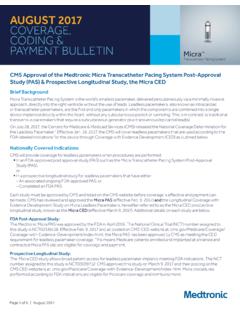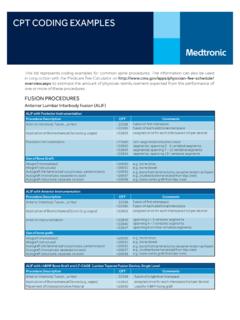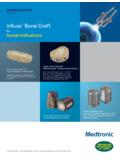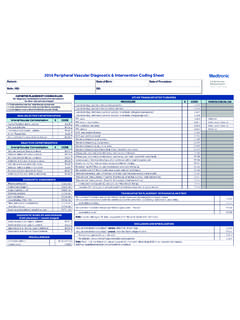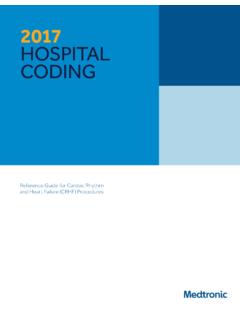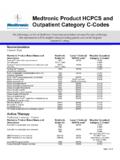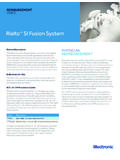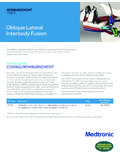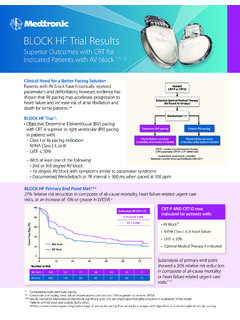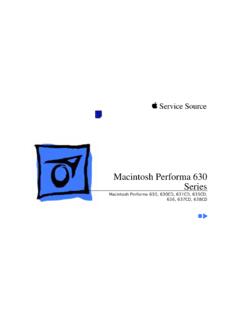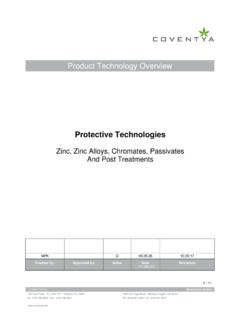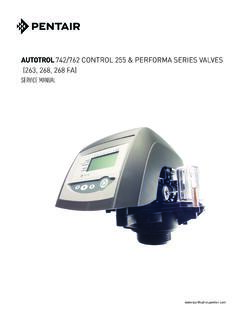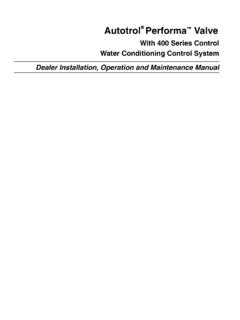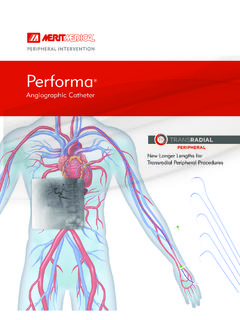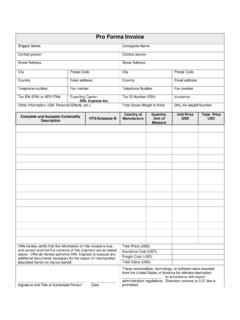Transcription of ATTAIN PERFORMA MRI SURESCAN MODEL 4298 - Medtronic
1 AT TA I N PERFORMA MRI SURESCAN MODEL 4298 Steroid-eluting, quadripolar electrode, transvenous, over-the-wire, cardiac vein pacing leadProduct specificationsPhysical characteristicsSerial number prefixQUATy p eQuadripolar electrodeChamber pacedLeft ventricleLength78 and 88 cm ( and in)ConnectorIS4-LLLLM aterialConductor25% Ag-core-MP35 NInsulatorsPolyurethane (outer) SI-polyimide (SI-PI) (inner)aElectrodesPlatinum iridium alloy with titanium nitride coatingConnector pinMP35 NConnector ringsMP35 NMolded tip sealSilicone rubberElectrode configurationRadiused, titanium-nitride-coated, steroid-elutingDiameterLead mm ( French) mm ( French)Spacer between electrodes LV1 (distal) and mm ( French)Spacer between electrodes LV2 a n d LV mm ( French)Spacer between electrodes LV3 and LV4 (proximal) mm ( French) Medtronic delivery system(recommended inner diameter) mm ( French)Diagnostic guide wire(recommended diameter) mm to mm( in to in)Electrode surface mm2 Distance between electrodesElectrode LV1 (distal) to LV221 mmElectrode LV2 to mmElectrode LV3 to LV4 (proximal)21 mmConductor resistanceLV 122 5 (78 cm)24 6 (88 cm)LV 219 4 (78 cm)21 5 (88 cm)LV 318 4 (78 cm)21 4 (88 cm)LV417 4 (78 cm)20 4 (88 cm)SteroidDexamethasone acetateTarget dose of steroid72 g at each monolithic controlled release device (MCRD)
2 288 g target combined amountSteroid binderSilicone rubbera Technology developed by Electrode LV1 (the distal electrode): nominally mm2 geometric pacing surface area2 Electrode LV2: nominally mm2 geometric pacing surface area3 Electrode LV3: nominally mm2 geometric pacing surface area4 Electrode LV4 (the proximal electrode): nominally mm2 geometric pacing surface area5 Anchoring sleeve6 IS4 connector7 C o n t a c t LV48 Contact LV39 C o n t a c t LV 210 C o n t a c t LV EN Medtronic 2015. Minneapolis, MN. All Rights Reserved. Printed in USA. 11/2015 Medtronic710 Medtronic Parkway Minneapolis, MN 55432-5604 USA Tel: (763) 514-4000 Fax: (763) 514-4879 Toll-free: 1 (800) 328-2518(24-hour technical support for physicians and medical professionals) Brief Statement ATTAIN Ability and ATTAIN PERFORMA MRI SURESCAN Leads IndicationsThe ATTAIN Ability 4196, 4296, and 4396 steroid eluting, dual electrode, IS-1 transvenous leads are indicated for chronic pacing and sensing in the left ventricle via the cardiac vein, when used in conjunction with a compatible Medtronic Cardiac Resynchronization Therapy (CRT) system.
3 Extended bipolar pacing is available using these leads in combination with a compatible CRT-D system and RV defibrillation lead or with a compatible CRT-P system* and RV pacing lead. Unipolar pacing is available using the leads in combination with a compatible CRT-P ATTAIN PERFORMA 4298, 4398, 4598 steroid eluting, quadripolar electrode, IS4 transvenous leads are indicated for chronic pacing and sensing in the left ventricle via the cardiac vein, when used with a compatible Medtronic Cardiac Resynchronization Therapy (CRT) system. Extended bipolar pacing is available using this lead in combination with a compatible CRT-D system and RV defibrillation ATTAIN Ability MRI SURESCAN and ATTAIN PERFORMA MRI SURESCAN Leads are part of the Medtronic SURESCAN Implantable Cardioverter Defibrillator with Cardiac Resynchronization (CRT-D) system.
4 A complete SURESCAN CRT-D system is required for use in the MR environment and includes a Medtronic SURESCAN device connected to Medtronic SURESCAN ATTAIN Ability leads are contraindicated for the following:Coronary vasculature These leads are contraindicated for patients with coronary venous vasculature that is inadequate for lead placement, as indicated by use Do not use in patients for whom a single dose of 232 g of dexamethasone acetate cannot be ATTAIN PERFORMA leads are contraindicated for the following:Coronary vasculature These leads are contraindicated for patients with coronary venous vasculature that is inadequate for lead placement, as indicated by use Do not use in patients for whom a single dose of 288 g of dexamethasone acetate may be and PrecautionsDiathermy is a treatment that involves the therapeutic heating of body tissues.
5 Diathermy treatments include high frequency, short wave, microwave, and therapeutic ultrasound. Except for therapeutic ultrasound, do not use diathermy treatments on cardiac device patients. Diathermy treatments may result in serious injury or damage to an implanted device and lead system. Therapeutic ultrasound (including physiotherapy, high intensity therapeutic ultrasound, and high intensity focused ultrasound), is the use of ultrasound at higher energies than diagnostic ultrasound to bring heat or agitation into the body. Therapeutic ultrasound is acceptable if treatment is performed with a minimum separation distance of 15 cm (6 in) between the applicator and the implanted device and lead system, as long as the ultrasonic beam is pointing away from the device and lead complete SURESCAN CRT-D system is required for use in the MR environment.
6 Before performing an MRI scan, refer to the SURESCAN MRI Technical Manual for important information about procedures and MRI-specific warnings and precautions. Patients and their implanted systems must be screened to meet the following requirements for MRI: no implanted lead extenders, lead adaptors, or abandoned leads; for patients with multiple MR-Conditional devices present, the MR labeling conditions for all implants are satisfied; no broken leads or leads with intermittent electrical contact as confirmed by lead impedance history; the SURESCAN CRT-D system is implanted in the left or right pectoral region; the CRT-D device is operating within the projected service life; no diaphragmatic stimulation at a pacing output of V and at a pulse width of ms in patients whose device will be programmed to an asynchronous pacing mode when MRI SURESCAN is programmed to On.
7 For pacemaker-dependent patients, it is not recommended to perform an MRI scan if the right ventricular (RV) lead pacing capture threshold is greater than V at ms. A higher pacing capture threshold may indicate an issue with the implanted may be scanned using a horizontal field, cylindrical bore, clinical MRI system with operating frequency of 64 MHz, maximum spatial gradient 20 T/m, and maximum gradient slew rate performance per axis 200 T/m/s. Scanner must be operated in Normal Operating Mode (whole body averaged specific absorption rate (SAR) W/kg, head SAR W/kg).The MODEL 4196, 4296, and 4396 leads were designed for optimal pacing when used in a unipolar or extended bipolar configuration.
8 The standard bipolar configuration may result in markedly elevated pacing thresholds or produce anodal ComplicationsPotential complications related to the use of transvenous leads include, but are not limited to, the following patient-related conditions: air embolism; avulsion or other damage to the endocardium, valve, or vein (particularly in fragile hearts); cardiac dissection; cardiac perforation; cardiac tamponade; coronary sinus dissection; death; endocarditis; erosion through the skin; extracardiac muscle or nerve stimulation; fibrillation or other arrhythmias; heart block; heart wall or vein wall rupture; hematoma/seroma; infection; lead conductor fracture or insulation failure; lead dislodgement; myocardial irritability; myopotential sensing; pericardial effusion; pericardial rub; pericarditis; pneumothorax; rejection phenomena (local tissue reaction, fibrotic tissue formation); threshold elevation or exit block; thrombosis; thrombotic SURESCAN CRT-D system has been designed to minimize potential complications in the MRI environment.
9 Potential MRI complications include, but are not limited to, lead electrode heating and tissue damage resulting in loss of sensing or capture or both, or induced currents on leads resulting in continuous capture, VT/VF, and/or hemodynamic the MRI SURESCAN Technical Manual before performing an MRI Scan and Device Manual for detailed information regarding the implant procedure, indications, contraindications, warnings, precautions, and potential complications/adverse events. For further information, please call Medtronic at 1 (800) 328-2518 and/or consult Medtronic s website at or : Federal law (USA) restricts this device to sale by or on the order of a physician.* Medtronic does not currently market any MR-Conditional CRT-P devices.
